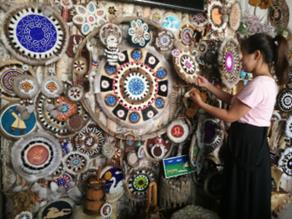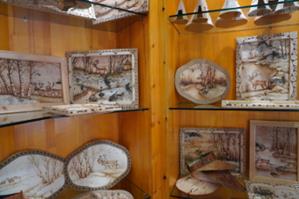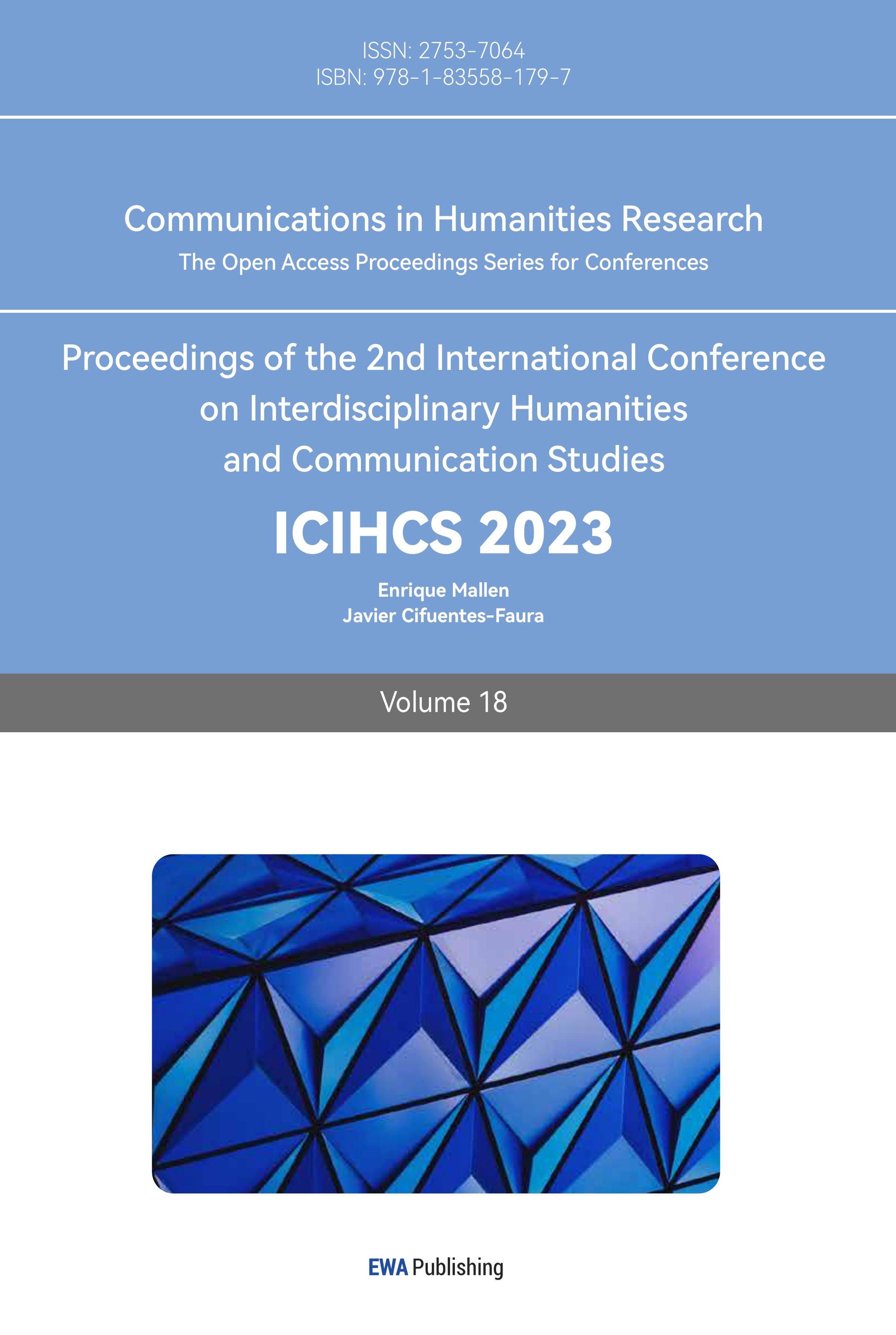1.Introduction
With the advancement of technology and the proliferation of digital techniques in digital art, the fusion of traditional culture and modern technology has become a focal point in various fields. Digital art, as a powerful creative tool, has opened up new possibilities across various domains. In the realm of fashion design, digital art has paved the way for innovation and preservation in traditional attire. The Aoluguya Ewenki ethnic group, a significant ethnic group in Northeast China, possesses a distinct cultural heritage and traditional clothing. Their traditional attire, crafted from materials like sheepskin and fur, features clean lines, earthy colors, and an innate sense of primitive beauty. In today’s digital age, the challenge lies in how to protect and pass down this unique cultural heritage, a crucial concern for local ethnic cultural preservation efforts. This paper aims to explore the application of digital art in the innovative design of traditional Aoluguya Ewenki ethnic costumes, with a special focus on the inheritance and development in the realm of virtual film and television. This endeavor seeks to drive innovation in traditional culture, promote cultural values, and provide valuable insights into the application of traditional attire in the digital era. By infusing traditional culture with new vitality and allure through digital art, this research continuously pushes it towards the intersection of purity and modernity. Through the application of digital technology, it offers better protection, promotion, and development opportunities for the inheritance of Aoluguya Ewenki ethnic costumes, injecting new vigor into the preservation of their traditional cultural heritage.
2.The Aoluguya Ewenki Ethnic Group and Traditional Attire
The Aoluguya Ewenki ethnic group, also known as the Evenki, is an indigenous ethnic group in Northeast China, primarily residing in the eastern regions of Inner Mongolia Autonomous Region and the northern parts of Heilongjiang Province. With a history dating back centuries, this ethnic group has developed unique ways of life and cultural traditions within challenging natural surroundings. The Ewenki people are renowned for their rich hunting culture and close connection with nature, where their lives and traditional attire reflect profound understanding and adaptability to the environment.

Figure 1: Aoluguya Ewenki traditional women’s robe [1].
Traditional ethnic attire serves not only as clothing but also as an expression of culture and identity. The traditional clothing of the Ewenki ethnic group reflects their history, way of life, and values. Typically, the styles and cuts of traditional Ewenki attire are designed to suit their living environment and needs. Men’s attire is often crafted from thick fur, such as deer or wolf skins, to provide warmth and protection against severe cold. These garments are typically in the form of robes that cover the entire body, offering both ease of movement and resistance against harsh weather conditions. Women’s clothing places a greater emphasis on decorative details, featuring more colorful elements and embroidery. In the Ewenki culture, green represents the lush forest, earthy yellow symbolizes the bountiful land, and red signifies the thriving campfire. Therefore, their attire incorporates shades of green, earthy yellow, and red in addition to leather materials. The Ewenki people worship the sun, and the reindeer is a symbol of their ethnicity, so their clothing often features motifs like reindeer totems or sunflowers, which carry auspicious meanings. Additionally, various plant fibers, bird feathers, and colorful stones from nature are used for embellishments, adding depth and aesthetic appeal to their attire.

Figure 2: Aoluguya Ewenki ethnic sunflower [2].
The patterns and decorations on traditional attire often hold specific symbolic meanings for the Ewenki ethnic group, tied to their religion, history, and legends. For instance, some patterns on their clothing may depict hunting scenes, expressing gratitude and reliance on nature. Meanwhile, the colors and shapes of these patterns may convey auspicious and blessing symbols [3].

Figure 3: Aoluguya Ewenki ethnic “birch bark culture” [4].
Traditional ethnic attire is more than just ornamentation; it carries profound symbolic significance. It serves as a marker of identity and cultural belonging for the Ewenki people, showcasing their close connection to the land and environment. The patterns, totems, and decorations on these garments convey insights into life and nature, embodying the history and wisdom of the ethnic group. Traditional attire also plays a vital role in social and religious ceremonies, representing the cohesion of the ethnic group and their traditional values [5].
3.Digital Art and Innovation in Fashion Design
Digital art has emerged as a form of creative expression that combines digital technology and artistic creation, resulting in new visual and perceptual experiences. It spans various domains, including digital painting, digital sculpture, virtual reality, and more. With technological advancements, digital art has not only provided artists with additional creative tools and mediums but has also opened up entirely new possibilities in the realm of creation by merging traditional and digital elements to craft unique art forms.
3.1.The Application of Digital Art in Fashion Design
The application of digital art in the field of fashion design represents an innovative approach that equips designers with an array of creative tools and mediums, enabling them to create distinctive and eye-catching clothing pieces. Digitized fashion design allows designers to use digital drawing software to craft virtual clothing designs swiftly, from initial sketches to detailed patterns, facilitating rapid design creation, modification, and adjustment. This heightened flexibility empowers designers to create diverse clothing styles, patterns, and color schemes while easily modifying and adjusting designs, thereby enhancing creative efficiency.
In the realm of virtual film and animation, digital art enables designers to craft a multitude of virtual attire, forging unique character images that showcase various styles and cultural elements within virtual worlds. Additionally, digital customization, facilitated by digital technology, allows customers to select patterns, colors, and styles on digital platforms, achieving unique virtual clothing customization. These applications collectively drive innovation and development in the field of virtual fashion design. The utilization of digital art not only promotes innovation and diversification in fashion design but also enhances the precision of the design process, providing a better interactive experience for users. It paves the way for designers to explore entirely new creative domains, fostering the advancement of the fashion industry [6].
3.2.The Impact of Digital Art on Innovative Traditional Attire
Digital art injects modern elements into traditional attire, enabling traditional clothing to align with contemporary fashion trends. Through digital technology, designers can create unique patterns, cuts, and styles, infusing new vitality into traditional attire, thus capturing the attention of younger generations interested in traditional cultural arts.
Digital art has brought revolutionary changes to how traditional attire is presented. Virtual reality technology allows people to experience traditional cultures by virtually wearing traditional attire from entirely new perspectives. Digital technology, through interactive elements and multimedia presentations, allows audiences to gain a deeper understanding of the history and significance of traditional attire. Furthermore, digital art provides a new platform for innovative developments in traditional attire, combining tradition and innovation. This not only preserves the core of traditional culture but also infuses it with fresh imagination and creativity, facilitating better inheritance and development of traditional attire in modern society, thereby preserving its vitality and appeal [7]. Through digital technology, innovative traditional attire can transcend geographical and cultural boundaries, making it easier to connect with global audiences. Digital display and communication methods, such as social media and virtual exhibitions, enable traditional attire to convey its cultural value and aesthetic characteristics more widely. These transformations not only amplify the influence of traditional attire but also enrich people’s understanding of cultural diversity, opening up new avenues for the future development of traditional clothing.
4.The Prospects of Digital Technology and Ethnic Clothing Design
4.1.Challenges and Opportunities in the Digital Age
In the digital age, traditional attire faces a range of challenges and opportunities that shape the interaction between fashion design and traditional culture. Challenges include the risk of cultural loss and homogenization. Globalized dissemination in the digital era may lead to the assimilation or misunderstanding of traditional attire, resulting in cultural loss and homogenization, thus losing its uniqueness. The rapid pace of fashion trends and digital platforms such as social media can make it challenging for traditional attire to keep up, potentially leading to marginalization. Additionally, issues related to design protection and infringement pose challenges. In the digital age, concerns arise regarding intellectual property rights and design protection, where traditional attire patterns and elements may be misappropriated or infringed upon, affecting the rights of original designers [8]. However, within these challenges, significant opportunities lie. The digital age provides a platform for both cultural preservation and innovation for traditional attire. Digital art revolutionizes the presentation of traditional attire. Virtual reality technology allows individuals to experience traditional cultures from entirely new perspectives. Digital technology, through interactive elements and multimedia presentations, enables audiences to gain a deeper understanding of the history and significance of traditional attire. Furthermore, digital art innovation platforms combine tradition and innovation, preserving the core of traditional culture while infusing it with fresh imagination and creativity. This facilitates the better inheritance and development of traditional attire in modern society, maintaining its vibrancy and allure. Display and interactive experiences allow people to gain a deeper understanding of the history and culture of traditional attire. The digital age brings numerous opportunities for traditional attire while also requiring strategies to maximize the role of digital technology in the protection and innovation of traditional attire when necessary.
4.2.The Inheritance and Development of the Ewenki Culture in the Digital Context
With the rapid development of digital technology, the Ewenki culture faces new opportunities and challenges in terms of inheritance and development. Cultural inheritance in the digital context involves not only preserving tradition but also integrating it into modern society to ensure the vitality of this precious ethnic culture amidst changing times.
In the digital context, the inheritance and development of Ewenki culture exhibit unique trends, particularly in the domain of virtual film and animation. Digital technology provides an entirely new platform, merging traditional culture with modern media and promoting the inheritance and development of Ewenki culture. Digitized patterns and embroidery inject fresh innovative elements into virtual film and animation. Designers can use digital technology to deconstruct, process, and reinterpret traditional patterns, enabling better presentations in the virtual world. Through online education, virtual film, and other technologies, younger generations can gain a more intuitive understanding and experience of Ewenki culture, strengthening their cultural identity [9].
Virtual film and animation, as innovative forms of expression, infuse new vitality into Ewenki culture. It allows the virtual representation of traditional clothing, customs, and rituals, providing audiences with a more immersive experience of the unique charm of this ethnic group. Virtual film and animation also offer dynamic ways to present traditional cultural stories and legends. Through dynamic images, sound, and other interactive elements, it vividly conveys the culture’s essence, allowing participants to experience the beauty and history of traditional attire firsthand. Furthermore, the global nature of virtual film and animation’s dissemination allows Ewenki culture to transcend geographical and national boundaries, aiding in the protection and inheritance of these valuable cultural heritages and providing essential resources for future generations’ learning and re-creation.
5.Conclusion
In the digital age, digital art plays a vital role in the innovative design and cultural inheritance of Ewenki ethnic fashion. Through the application of digital technology, traditional attire blends with modern elements, resulting in unique and creative works. Nevertheless, the inheritance and innovation within the digital context also come with challenges, such as fragmented information and cultural preservation. To achieve successful cultural inheritance and innovation, a balance between tradition and modernity is essential. Leveraging digital technology facilitates meaningful creation and protection, allowing Ewenki ethnic fashion to flourish under the guidance of digital art. The digital context offers unprecedented opportunities for cultural inheritance, promoting intergenerational transmission and global dissemination.
References
[1]. Image and relevant information source: Self-captured by the author.
[2]. Image and relevant information source: Aoluguya Evenki Ethnic Sunflower. Retrieved from https://baijiahao.baidu.com/s?id=1608493403072798929&wfr=spider&for=pc (Source: Xinhua News Agency, “Blossoming ‘Sunflower’ of the Ewenki Ethnic Group on the Inheritance Road”).
[3]. Schentoya, Toru Nakayama. The life appearance of Daur herdsmen in grassland area and the pattern change of nomads: A case study of the Daur nationality Township of Bayantala, Ewenki Autonomous Banner, Hulunbuir City [J]. 112-116. Journal of the Japan Domestic Economics Association, JPN(2022).
[4]. Image and relevant information source: Aoluguya Evenki Ethnic “Birch Bark Culture”. Retrieved from : https://mp.weixin.qq.com/s?__biz=MzA3NTM1NzMxNQ==&mid=2650476661&idx=3&sn=f15c7a99d762a0319990eb72fe820f7a&chksm=877e7d99b009f48f568da98ce3fa48139381d6cfd366b7c88ab738f17f1c946eb61fb49f3251&scene=27 (Source: Genhe City Culture and Tourism Bureau).
[5]. [5] ᠭᠦᠩ ᠢᠤᠢ. ᠤᠯᠭᠤᠶᠠ ᠶᠢᠨ ᠪᠤᠭᠤᠴᠢᠨ ᠡᠸᠩᠬᠢᠴᠤᠳ ᠤᠨ ᠤᠯᠠᠮᠵᠢᠯᠠᠯᠲᠤ ᠬᠤᠪᠴᠠᠰᠤ ᠵᠠᠰᠠᠯ ᠵᠢᠴᠢ ᠲᠡᠭᠦᠨ ᠢ ᠬᠡᠷᠬᠢᠨ ᠬᠠᠮᠠᠭᠠᠯᠠᠵᠤ ᠬᠦᠭᠵᠢᠬᠦᠯᠬᠦ ᠲᠤᠬᠠᠢ (The Traditional Costumes of the Hongyude Aolugu Yabu Guchu People and How They Are Protected and Developed.) [J]. 1-4. Inner Mongolia Social Sciences (Mongolian Edition), MN(2016).
[6]. Li, L. L., & Zong, M. M. (2012). Protection and Inheritance of Traditional Costume of the Ewenki Ethnic Group. Popular literature and art: Academic Edition, 12-14. [CN(2012)].
[7]. Qi, Y. (2023). Ewenki Traditional Costume and Its Folk Cultural Connotations. Bai Hua, 2-6. [CN(2023)].
[8]. Zhang, J. J., & Pan, B. (2015). A Costume Art Education Resource Library with a Distinctive Feature for Cultural Heritage Preservation. Art & Design Research, 6-9. [CN(2015)].
[9]. Yi, Q. Y. (2014). Application of 3D Printing Technology in Stereoscopic Modeling of Ethnic Costumes. Yi Hai, 16-20. [CN(2014)].
Cite this article
Wang,C.;Yang,Z. (2023). Innovative Design of Traditional Costumes in Digital Art: A Case Study of the Aoluguya Evenki Ethnic Group in Northeast China. Communications in Humanities Research,18,29-34.
Data availability
The datasets used and/or analyzed during the current study will be available from the authors upon reasonable request.
Disclaimer/Publisher's Note
The statements, opinions and data contained in all publications are solely those of the individual author(s) and contributor(s) and not of EWA Publishing and/or the editor(s). EWA Publishing and/or the editor(s) disclaim responsibility for any injury to people or property resulting from any ideas, methods, instructions or products referred to in the content.
About volume
Volume title: Proceedings of the 2nd International Conference on Interdisciplinary Humanities and Communication Studies
© 2024 by the author(s). Licensee EWA Publishing, Oxford, UK. This article is an open access article distributed under the terms and
conditions of the Creative Commons Attribution (CC BY) license. Authors who
publish this series agree to the following terms:
1. Authors retain copyright and grant the series right of first publication with the work simultaneously licensed under a Creative Commons
Attribution License that allows others to share the work with an acknowledgment of the work's authorship and initial publication in this
series.
2. Authors are able to enter into separate, additional contractual arrangements for the non-exclusive distribution of the series's published
version of the work (e.g., post it to an institutional repository or publish it in a book), with an acknowledgment of its initial
publication in this series.
3. Authors are permitted and encouraged to post their work online (e.g., in institutional repositories or on their website) prior to and
during the submission process, as it can lead to productive exchanges, as well as earlier and greater citation of published work (See
Open access policy for details).
References
[1]. Image and relevant information source: Self-captured by the author.
[2]. Image and relevant information source: Aoluguya Evenki Ethnic Sunflower. Retrieved from https://baijiahao.baidu.com/s?id=1608493403072798929&wfr=spider&for=pc (Source: Xinhua News Agency, “Blossoming ‘Sunflower’ of the Ewenki Ethnic Group on the Inheritance Road”).
[3]. Schentoya, Toru Nakayama. The life appearance of Daur herdsmen in grassland area and the pattern change of nomads: A case study of the Daur nationality Township of Bayantala, Ewenki Autonomous Banner, Hulunbuir City [J]. 112-116. Journal of the Japan Domestic Economics Association, JPN(2022).
[4]. Image and relevant information source: Aoluguya Evenki Ethnic “Birch Bark Culture”. Retrieved from : https://mp.weixin.qq.com/s?__biz=MzA3NTM1NzMxNQ==&mid=2650476661&idx=3&sn=f15c7a99d762a0319990eb72fe820f7a&chksm=877e7d99b009f48f568da98ce3fa48139381d6cfd366b7c88ab738f17f1c946eb61fb49f3251&scene=27 (Source: Genhe City Culture and Tourism Bureau).
[5]. [5] ᠭᠦᠩ ᠢᠤᠢ. ᠤᠯᠭᠤᠶᠠ ᠶᠢᠨ ᠪᠤᠭᠤᠴᠢᠨ ᠡᠸᠩᠬᠢᠴᠤᠳ ᠤᠨ ᠤᠯᠠᠮᠵᠢᠯᠠᠯᠲᠤ ᠬᠤᠪᠴᠠᠰᠤ ᠵᠠᠰᠠᠯ ᠵᠢᠴᠢ ᠲᠡᠭᠦᠨ ᠢ ᠬᠡᠷᠬᠢᠨ ᠬᠠᠮᠠᠭᠠᠯᠠᠵᠤ ᠬᠦᠭᠵᠢᠬᠦᠯᠬᠦ ᠲᠤᠬᠠᠢ (The Traditional Costumes of the Hongyude Aolugu Yabu Guchu People and How They Are Protected and Developed.) [J]. 1-4. Inner Mongolia Social Sciences (Mongolian Edition), MN(2016).
[6]. Li, L. L., & Zong, M. M. (2012). Protection and Inheritance of Traditional Costume of the Ewenki Ethnic Group. Popular literature and art: Academic Edition, 12-14. [CN(2012)].
[7]. Qi, Y. (2023). Ewenki Traditional Costume and Its Folk Cultural Connotations. Bai Hua, 2-6. [CN(2023)].
[8]. Zhang, J. J., & Pan, B. (2015). A Costume Art Education Resource Library with a Distinctive Feature for Cultural Heritage Preservation. Art & Design Research, 6-9. [CN(2015)].
[9]. Yi, Q. Y. (2014). Application of 3D Printing Technology in Stereoscopic Modeling of Ethnic Costumes. Yi Hai, 16-20. [CN(2014)].









